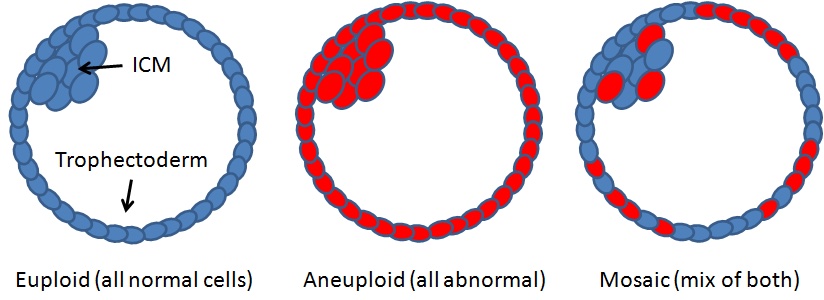Mosaic embryos

If you have done PGT-A/PGS you have probably heard the term “mosaic embryo”. What exactly are mosaic embryos?
When we do PGS testing (PGT-A) we are analyzing a few cells of the embryo to see if they’re normal or abnormal. What makes a “normal” cell has to do with the number of chromosomes in the cell.
Chromosomes are how our cells package our DNA. We have so much DNA in our cells that if you were able to stretch it out, it would be about 2 meters (6 feet) in length! Imagine stuffing all of that into a tiny cell - it needs a great deal of packaging to get it all in there. Chromosomes are how our cells pack this DNA up.
There’s 46 chromosomes in humans, and that’s the number we hope to see in our embryos. We call the normal number (46) of chromosomes “euploid”. Anything besides this number is aneuploid. Here’s a picture of what a euploid cell would look like with its 46 chromosomes:

Embryos that have aneuploid cells, or have cells that don’t have 46 chromosomes, are believed to have a higher chance of miscarriage. And euploid embryos, with 46 chromosomes, are believed to have a higher chance of pregnancy.
So embryos can be euploid and have all normal cells, or they can be aneuploid and have all abnormal cells. In the old days this was the information we were given when performing PGS testing.
These days, the technology has advanced and we can actually see if there’s a mix of good and bad cells. We call these embryos mosaic.

There can be different percentages of aneuploid cells in a mosaic embryo. So a 40% mosaic embryo has 40% aneuploid cells and 60% euploid cells.
In terms of success rates, mosaic embryos are believed to be in between euploid and aneuploid. There’s some evidence that’s showing that low level mosaics (mosaics with <40% aneuploid cells) perform just as well as euploid embryos.
Mosaic embryos might “self-correct” and the idea here is that the mosaic embryo, with its mix of euploid and aneuploid cells, becomes normal. This can happen because the aneuploid cells might die, or might grow so slow compared to the euploid cells that the euploid cells eventually take over the whole embryo as the embryo develops.
Perhaps the biggest concern with mosaic embryos isn’t their intermediate success rates but is the potential for a live birth with a defect. For example, trisomy 21 causes Down syndrome. If you have a mosaic embryo where 20% of the cells have trisomy 21, would you feel comfortable transferring it?
It’s possible that the embryo might self-correct, but this isn’t a guarantee. For this reason, there’s guidelines in place to prevent transferring mosaics that are at high risk for leading to an abnormal pregnancy.
Check out my blog on mosaic embryos for more details and statistics on success rates - https://www.remembryo.com/mosaic-embryo/
Follow me on Instagram to learn more about IVF and embryology: https://www.instagram.com/embryomanofficial/
Recent blog posts
Living with endometriosis: The hidden battle
Endometriosis affects approximately 1 million Canadians and there is no known cure. But what exactly is endometriosis and what are the risks?
Excerpt from the memoir “How to Get a Girl Pregnant”
Waiting. Waiting. Waiting. Can I fill up the day with 16 separate tasks so that I don’t think about waiting?
Just Adopt
There’s really no escaping it. When you’re facing infertility, other people getting into your business begins to feel pretty routine.




